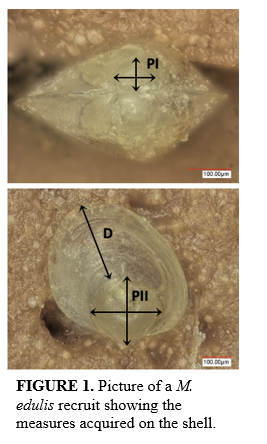IMPACT OF SOUND INTENSITY RELATED TO MARITIME TRANSPORT ON THE EMBRYOGENESIS AND METAMORPHOSIS OF THE BLUE MUSSEL Mytilus edulis
The blue mussel Mytilus edulis is a sessile organism with a major role in the development, the functioning and the sustainability of coastal environments but also reared in shellfish farms located in coastal areas under high anthropogenic influence. In recent years, maritime traffic activity has considerably increased with a serious concern about the effects of sounds generated by ships, considered as an emerging pollutant. Impact of ship underwater noise on the larval development and the subsequent recruitment success of the blue mussels is the objective of this study. We present for the first time the impact of a cargo ship sound on both embryos and competent larval stages of blue mussels at different levels of stress, by correlating the complementary metabolomic, lipodomic, behavioral, growth and survival responses obtained.
A month-long experiment was conducted in Larvosonic mesocosms, created to emit sounds with low reverberation and resonance. Thus, we exposed developmental stages to contrasting sound treatments including a control (ambient sound) and three increasing levels (low, medium and high; from 132 to 150 dB re1µPa) of a previously in situ recorded sound sequence of a 120 m cargo ship. We suggest that critical windows to stress could occur during larval development, and thus tested several ontogenetic phases as embryogenesis (embryo to larva-D) and metamorphosis (pediveliger to post-larvae). Several analyzes were carried out to explore the primary, secondary and tertiary stress responses to sound including i) prostaglandins and oxidative metabolism, ii) energy metabolism and analysis of lipid profiles and iii) larval growth through shell measurements (Prodissoconch I, II and Dissoconch, Figure 1). Preliminary results show that larvae subjected to high sound intensity settle faster and have greater post-larval growth compared to other conditions. However, when they are subjected to lower sound intensities then a delay in metamorphosis seems to be observed.
